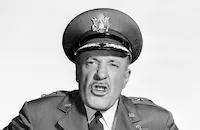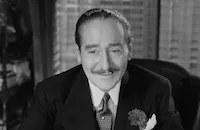The Fuzzy Pink Nightgown

Brief Synopsis
Cast & Crew
Norman Taurog
Jane Russell
Keenan Wynn
Ralph Meeker
Fred Clark
Una Merkel
Film Details
Technical Specs

Synopsis
When film star Laurel Stevens leaves her home to attend the premiere of her new film, The Kidnapped Bride , she is abducted by two bumbling, first-time kidnappers, Mike Valla and Dandy. At the theater, Laurel's agent, Barney Baylies, and Grandeur Studios' head, Arthur Martin, attempt to placate the press, particularly gossip columnist Daisy Parker, over Laurel's non-appearance. Meanwhile, Mike and Dandy drive Laurel to their hideout at the Malibu beach. Eventually, Arthur and Barney realize that Laurel may have been kidnapped, but agree that Bertha, Laurel's personal assistant, should wait until midnight before informing the police. At the house in Malibu, Laurel tries, unsuccessfully, to convince both Mike and Dandy to let her go. Elsewhere in the city, police sergeant Ed McBride, who was responsible for Mike serving a jail sentence for murder, but then got him released when he realized that Mike was innocent, is ordered to check on Mike's whereabouts. When Laurel discovers that Mike and Dandy intend to ransom her for fifty thousand dollars, she is insulted and says she is worth at least five hundred thousand dollars. Laurel then becomes concerned that the kidnapping could be perceived simply as a publicity stunt related to her new film and worries that it could seriously damage her career. After McBride tracks Mike to the house, Laurel threatens to make her presence known, so Mike knocks her out. When she recovers, she hears Mike and McBride discussing Mike's false imprisonment and decides, for fear of adverse publicity, that she should not involve the police in the kidnapping, but try to resolve the situation on her own. Laurel then passes herself off as Mike's girl friend and goes unrecognized by McBride. After McBride leaves, Laurel insists that the kidnapping be made to appear real enough so that it will not be perceived as a publicity gimmick. When Laurel is officially reported missing, McBride is assigned to the case and consults with Barney and Arthur, who offers a reward of one hundred thousand dollars for the capture of the kidnappers. Meanwhile, Laurel and Mike begin to fall in love. In order to make the kidnapping appear genuine, Mike arranges, through untraceable intermediaries, for Arthur to pay one hundred thousand dollars in cash as Laurel's ransom. Bertha is to take the money in a suitcase to the TWA ticket counter at Los Angeles International Airport, where Dandy works, and check it in. While visiting Arthur's office, McBride sees a studio portrait of Laurel, realizes where he has seen her and drives off in a great hurry. Laurel's situation becomes more complicated when she wakens with a hangover and discovers that she has asked Dandy to elope with her. Later, after Dandy has gone to the ticket counter to collect the suitcase with the ransom money, Mike and Laurel realize that they are in love and, ignoring the potential damage to her career, decide to prevent Dandy from receiving the ransom money. As they are about to leave, McBride arrives, but Laurel knocks him out and she and Mike race to the airport in McBride's patrol car. At the airport, Bertha, observed by numerous undercover police officers, checks in the suitcase at Dandy's counter, but he mixes it up with a similar suitcase. Mike and Laurel then take the suitcase from Dandy, intending to return it to Arthur. As they attempt to leave, McBride arrives to arrest Mike and Dandy. When he opens the suitcase, however, there is no money inside and Laurel saves Mike and Dandy from prosecution by declaring that they are her publicity agents, hired to stage the kidnapping. Mike and Laurel then embrace.q

Director

Norman Taurog
Cast

Jane Russell

Keenan Wynn

Ralph Meeker

Fred Clark

Una Merkel
Robert Harris
Benay Venuta
Bob Kelley
Dick Haynes
John Truax
Milton Frome

Adolphe Menjou
Howard Mcnear
Crew
Annabell
Joseph C. Behm
Layne Britton
Evelyn Carruth
Richard Carruth
Stanley H. Goldsmith
Serge Krizman
Joseph La Shelle
Fred Lau
Archie Marshek
Billy May
Norman Rockett
Oscar Rodriguez
Arthur Rosson
Richard Alan Simmons
Jack Stubbs
Billy Travilla
Robert Waterfield

Film Details
Technical Specs

Articles
The Fuzzy Pink Nightgown
The 1950s was the decade of the blonde bombshell as typified by McDonald, Marilyn Monroe and Jayne Mansfield. So, in 1957 brunette bombshell Russell donned a blonde wig for the film version of The Fuzzy Pink Nightgown. She also hired director Norman Taurog, who had won an Oscar® in 1931 for Skippy (starring his nephew, Jackie Cooper), and would spend the 1960s directing Elvis Presley films. Richard Alan Simmons, (who would later produce several Columbo television films) adapted the novel into a screenplay. For co-stars, Russ-Field got Keenan Wynn, Fred Clark, Adolphe Menjou and Una Merkel. Director Taurog had wanted Dean Martin to play the kidnapper, Mike Valla, but the part eventually went to Ralph Meeker. Singer Dick Haynes played a DJ and Bob Kelley played a television announcer. Kelley had been the announcer for the Los Angeles Rams since 1937 and Robert Waterfield had once played for the team and later became a coach.
The critics were not impressed with The Fuzzy Pink Nightgown; The New York Times wrote that "An ordinary piece of feminine night clothing is a pretty flimsy excuse for putting together a long, long movie. This happens to be the case even though the girl in the bedtime get-up is Jane Russell. Miss Russell, cast as a movie star who is abducted by a couple of good guys gone sour on the law, can keep the nightgown hanging properly. But she cannot disentangle herself from a smothering yarn that finds her in no time an accessory to her own kidnapping. This baseless turnabout occurs for no better reason than the fact that Ralph Meeker, as one of the abductors, would really rather play house than gangster, and because Miss Russell, underneath the key garment, has a loving and lonely heart. Also muffled in this matted yarn is the amusing Keenan Wynn, who bluffs his way to a few laughs as Mr. Meeker's assistant. As pointed out, it is no quick unraveling to the happy ending. There is a lot of talk about the emptiness of movie stardom and about the reason a swell pipe-smoking guy like Mr. Meeker pulled such a trick. Most of the talking, which in the script by Richard Alan Simmons is without point or humor, is done by Miss Russell. After all, pretty girls in fuzzy nightgowns should be seen and not heard. That goes for her kidnappers, too."
Part of the problem, Russell later wrote, was that The Fuzzy Pink Nightgown was in black-and-white, rather than Technicolor. Russell had conceived the film as a suspenseful drama whereas Taurog thought it should be a Technicolor comedy. She later said, "It was just as much my fault as the director's. It would have been much better if either one of us had been the boss." The film also suffered from tough competition - Will Success Spoil Rock Hunter? (1957) with Jayne Mansfield had been released three months earlier in July. As a result, The Fuzzy Pink Nightgown was the second money-loser for Russ-Field Productions (the first had been Gentlemen Marry Brunettes in 1955), and the failure of the film ended the company. The film would finally see a profit in the 1960s after several runs on television.
Producer: Robert Waterfield
Director: Norman Taurog
Screenplay: Richard Alan Simmons, Sylvia Tate (novel)
Cinematography: Joseph LaShelle
Film Editing: Archie Marshek
Art Direction: Serge Krizman
Music: Billy May
Cast: Jane Russell (Laurel Stevens), Keenan Wynn (Dandy), Ralph Meeker (Mike Valla), Fred Clark (Sergeant McBride), Una Merkel (Bertha), Adolphe Menjou (Arthur Martin).
BW-88m.
by Lorraine LoBianco
Sources:
The Internet Movie Database
The New York Times: The Fuzzy Pink Nightgown on View , October 31, 1957
Wikipedia.org
Meekermuseum.com
Killer Tomatoes: Fifteen Tough Dames by Ray Hagen and Laura Wagner
Radiotimes.com

The Fuzzy Pink Nightgown
Quotes
Trivia
Notes
An 8 August 1956 Hollywood Reporter news item stated that Jane Russell's company, Russ-Field, which she owned with husband Robert Waterfield, had purchased the rights to the newly published novel That Fluffy Pink Nightgown [sic] as its next production for United Artists release. The novel dealt with the kidnapping of a movie actress. Some sources, including Russell's autobiography, state that the film was inspired by the purported kidnapping of real-life movie actress Marie "The Body" McDonald, then married to shoe store mogul Harry Karl. However, the book had been published and the film was already shooting well before McDonald's alleged abduction in early January 1957. Los Angeles Times reported on January 14, 1957 that a copy of the novel had been found in McDonald's home. No one was ever convicted of the McDonald "kidnapping," and contemporary and modern sources doubted that a crime had taken place.
Exteriors for The Fuzzy Pink Nightgown were filmed in Malibu, Santa Monica, Westwood and at the original Los Angeles International Airport on West Imperial Highway. According to a January 1957 Hollywood Reporter news item, portions of the film were shot on Zuma Beach and Paradise Cove. After her kidnapping, "Laurel" is given a demure, fuzzy nightgown to replace the evening gown she was wearing for the premiere.
In her autobiography, Russell stated that director Norman Taurog, who had made a number of films with Dean Martin and Jerry Lewis, had tried to interest Martin in playing the role of "Mike." Although their appearance in the film has not been confirmed, Hollywood Reporter news items add Richard Geary, Barbara Marshall, Jane Burgess and Carmen Nisbet to the cast.

Miscellaneous Notes
Released in United States Summer August 1957
Released in United States Summer August 1957













